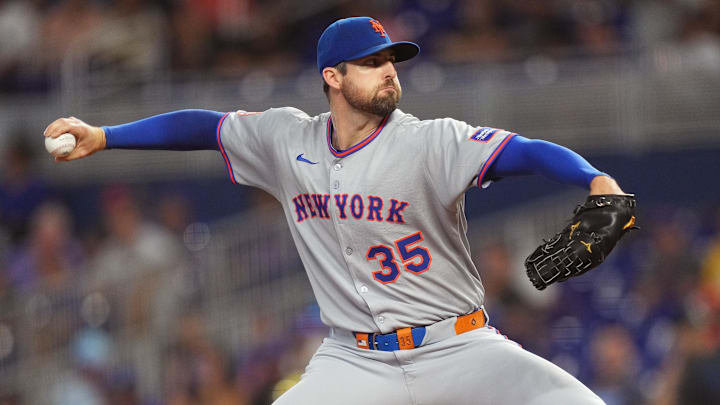The New York Mets signed right-handed pitcher Clay Holmes last offseason to a three-year contract. Despite becoming a two-time All-Star closer with the crosstown rival New York Yankees and only making four starts in 311 total appearances, the Mets brought him in as a starter. However, you don’t need Sherlock Holmes to find why Clay Holmes should go back into a relief pitching role in 2026.
On the surface, Holmes’ 3.53 ERA over 165.2 innings looks solid. It was the 20th lowest among any pitcher with at least 160 frames. However, a brief peek under the hood reveals that his ERA appears misleading. Holmes’ xERA was 4.39. That wasn’t the only ERA estimator that did not like his work in 2025. He also had a 4.11 FIP, 4.25 xFIP, and 4.43 SIERA. All of Holmes’ peripherals took a hit as well.
While Holmes never posted otherworldly strikeout numbers, he still had a solid 28.8% whiff rate and 26.7% strikeout rate. His strikeout rate this season fell by over 10% to just 18.2%, and he got a whiff less than a quarter of the time (22.1% to be exact). Holmes didn’t counteract the declining strikeout rate by becoming better at limiting walks. His free pass percentage got worse, going from 7.4% with the Yanks to 9.3% with the Mets.
His stuff also got much worse. Holmes had a 120 Stuff+ with the Yankees. That meant his stuff was 20% better than league average. The only Yankees pitcher during Holmes’ tenure with them who had a better Stuff+ was Jonathan Loaisia. He put up a career-high 126 mark in his contract season. Meanwhile, after moving to the rotation, he only had a 103 mark with the Mets. Holmes’ sinker velocity, which sat at 97.5 MPH with the Yankees, fell to 93.9 MPH with the Mets. A decrease in velocity was expected, however, given that he went from a reliever role to a starting pitching role. But the expected drop doesn’t justify the rest of his numbers.
Everything points toward Clay Holmes being more effective out of the Mets bullpen than out of their rotation in 2026.
The most worrying aspect of all was his peripherals were his batted ball numbers. Holmes was a groundball machine with the Yankees, and was by far his biggest strength. From 2022, his first full season in a Yankees’ uniform, through 2024, Holmes had a ground ball rate of 68.6%. That led all pitchers who tossed at least 180 innings over those three seasons. But as a starter with the Mets, his ground ball rate fell to 55.8%. That also led to his barrel rate going from 3.3% in his three prior seasons to a career-worst 6.8% rate. All of this culminated to a career-worst 0.76 HR/9. While these are still good numbers with the Mets, it’s still hard to ignore how much worse they got.
Even looking at Holmes’ splits as the game goes on shows why he needs to move to the bullpen. Through his first 25 pitches of a game, Holmes holds opponents to just a .210/.293/.301 slash with a 68 sOPS+. That’s not too unlike the .238/.305/.325 line and 81 sOPS+ he had on his first 25 pitches in 2024. However, on pitches 26-50, opponents upped their performance to a .254/.343/.348 line, and 96 sOPS+. His walk rate got dramatically worse, going from 8.1% on pitches 1-25 to 10.1% on pitches 26-50.
It doesn’t even take long for the cracks to start to show in Holmes’ starts. During the first inning of games this season, he held opponents to a .299 xwOBA, 25.5% whiff rate, and a 4.8% barrel percentage. Then, in inning number two, opponents owned him for a .348 xwOBA, 24.2% whiff rate, and 9.6% barrel rate. He gives up twice as many barrels in the second inning compared to the first inning.
It also makes sense to move Holmes to the bullpen, depth chart-wise. The Mets will have Nolan McLean in the starting five, with fellow rookies Brandon Sproat and Jonah Tong likely having an inside track for rotation spots. The Mets can make do with some mix of Kodai Senga, David Peterson, and Sean Manaea in the final three slots. Plus, they still have plenty of up-and-coming young arms in their system that could make their MLB debut in 2026, like Jack Wenninger, Zach Thornton, Will Watson, and Jonathan Santucci.
The Mets also need a set-up option. Ryan Helsley, Gregory Soto, Tyler Rogers, and Brooks Raley are all becoming free agents. The Mets’ leader in holds this year, Reed Garrett, struggled badly down the line before undergoing nerve surgery in his elbow in September. While the Mets still need to add bullpen depth this winter, moving Holmes to the pen alleviates some of their problems.
Everything points to Clay Holmes being a better option out of the bullpen than out of the rotation. He had better peripherals, better stuff, and better underlying numbers as a reliever. It also makes more sense given where the Mets’ current depth chart stands. Going into 2026, the Mets should make the decision to stick Holmes in the bullpen and return him to his role as a late-inning/high-leverage option once again.
